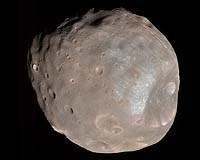 |
Paris, France (SPX) Mar 16, 2010 Images from the recent flyby of Phobos, taken on 7 March 2010 by the German Aerospace Center-operated (Deutsches Zentrum fur Luft- und Raumfahrt; DLR) High Resolution Stereo Camera (HRSC) on board Mars Express, are being released today. The images show Mars's rocky moon in exquisite detail, with a resolution of 4.4 metres per pixel, including the proposed landing sites for the forthcoming Phobos-Grunt mission. ESA's Mars Express spacecraft orbits the Red Planet in a highly-elliptical polar orbit that brings it close to Phobos every five months. It is the only spacecraft currently in orbit around Mars whose orbit reaches far enough from the planet to provide a close-up view of Phobos. Like our Moon, Phobos always shows the same side to the planet, so it is only by flying outside the orbit that it becomes possible to observe the far side. Mars Express did just this on 7, 10 and 13 March 2010. The spacecraft also collected valuable scientific data with other instruments. Phobos is an irregular body measuring some 27 � 22 � 19 kilometres, with debatable origins. It appears to share many surface characteristics with the 'carbonaceous C-type' asteroid class, which suggests that it might have been captured from this population. However, it is difficult to explain either the capture mechanism or the subsequent evolution of the orbit into the equatorial plane of Mars. An alternative hypothesis is that it formed around Mars, and is therefore a remnant from the planetary formation period. In 2011 Russia will send a mission called Phobos-Grunt (meaning Phobos Soil) to land on the martian moon, collect a soil sample and return it to Earth for analysis. It is expected that ESA ground stations will take part in controlling Phobos-Grunt, receiving telemetry and making trajectory measurements, including implementation of very long-baseline interferometry (VLBI). This cooperation is realised on the basis of an agreement between the Russian Federal Space Agency and ESA in the framework of the Phobos-Grunt and ExoMars projects. Mars Express will continue to encounter Phobos until the end of March, when the moon will pass out of range. During the remaining flybys, HRSC and other instruments will continue to collect data. The High Resolution Stereo Camera (HRSC) experiment on the European Space Agency's Mars Express mission is led by the Principal Investigator (PI) Prof. Dr Gerhard Neukum, who was also responsible for the technical design of the camera. The science team for the experiment consists of 45 Co-Investigators from 32 institutions and 10 nations. The camera was developed at the German Aerospace Center (DLR) under the leadership of the PI, G. Neukum, and built in cooperation with industrial partners (EADS Astrium, Lewicki Microelectronic GmbH and Jena-Optronik GmbH). The experiment on Mars Express is operated by the DLR Institute of Planetary Research, through ESA/ESOC. The systematic processing of the HRSC image data is carried out at DLR. The scenes shown here were processed by the PI-group at the Institute for Geosciences of the Freie Universit�t Berlin in cooperation with the DLR Institute of Planetary Research, Berlin.
Share This Article With Planet Earth
Related Links The best Mars images German Aerospace Center (DLR) Mars News and Information at MarsDaily.com Lunar Dreams and more
 Phobos Flyby Success
Phobos Flyby SuccessKoln, Germany (SPX) Mar 08, 2010 Mars Express encountered Phobos last night, smoothly skimming past at just 67 km, the closest any manmade object has ever approached Mars' enigmatic moon. The data collected could help unlock the origin of not just Phobos but other 'second generation' moons. Something is not right about Phobos. It looks like a solid object but previous flybys have shown that it is not dense enough to be so ... read more |
|
| The content herein, unless otherwise known to be public domain, are Copyright 1995-2010 - SpaceDaily. AFP and UPI Wire Stories are copyright Agence France-Presse and United Press International. ESA Portal Reports are copyright European Space Agency. All NASA sourced material is public domain. Additional copyrights may apply in whole or part to other bona fide parties. Advertising does not imply endorsement,agreement or approval of any opinions, statements or information provided by SpaceDaily on any Web page published or hosted by SpaceDaily. Privacy Statement |